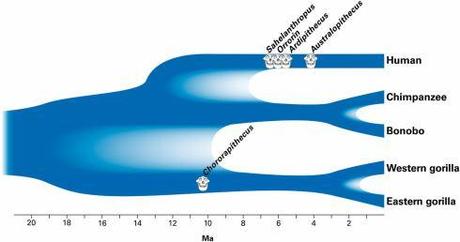Genetic data indicates humans and chimps split ~7 million years ago. This is typically calculated by looking at how many mutations separate us from chimps and the rate at which they occur. However, figuring out the mutation rate per year can be a bit tricky, so 2 years ago a team of researchers used an alternate approach where they figured out the mutation rate per generation; which is easier to do because you just look at how many mutations have occurred in kids compared to their parents. Based on this they estimated that chimps an humans split some point between 7 – 14 million years ago; almost double previous estimates[1]!

The recalculated divergence of humans and chimps
Which is kind of a big deal. It pushed back the time we split from Neanderthals from ~300 to ~700,000 years ago and could mean many extinct apes, once thought to be too old to be part of our family, could be reclassified as hominins. Given that nobody wants to deal with the trouble of rewriting all the textbooks this was obviously was treated with a degree of caution at the time. Two years on, has the debate been resolved? Shortly after the new estimates were published a pair of researchers voiced their concerns. They raised 3 main criticisms[2].
- Looking at the mutation rate per generation, whilst easier, typically underestimated the rate of mutation.
- It’s also a relatively new method, so only small sample sizes have been examined thus far. When more people are looked at, the slower rate may well disappear.
- And remember that news story a while ago about how the older a guy is when he has kids the more mutations the kids have? This is a real effect that could render the estimates inaccurate.
The original authors hit back, publishing a short response that dealt with these criticisms. They argued that the effects which result in generational mutation rate underestimating the overall rate of mutation are relatively minor and would not have a big influence on their results. However, they did acknowledge that the small sample sizes and variation in mutation rate could raise doubts over the accuracy of their estimates[3].
This is why they wound up with such a broad figure for the human/chimp divergence. 7 – 14 million years is quite a margin of error after all, overlapping with the old estimates at the lower end! So, whilst this new figure may not have any major problems it’s so inaccurate that we have no idea if it’s a significant result. We could expand the sample size it is based on, refine the results and at the end of the day re-conclude that humans and chimps split 7 million years ago; dashing my hopes of a revolutionary change to our understanding of human evolution. Fooey.
Hopefully the figure will be refined; and when that happens check back for a part 3! With a bit of luck this issue will be resolved before we start needing to count the number of parts on our toes.
References
- Langergraber, K. E., Prüfer, K., Rowney, C., Boesch, C., Crockford, C., Fawcett, K., … & Vigilant, L. (2012). Generation times in wild chimpanzees and gorillas suggest earlier divergence times in great ape and human evolution.Proceedings of the National Academy of Sciences, 109(39), 15716-15721.
- Gibb, G. C., & Hills, S. F. (2013). Intergenerational mutation rate does not equal long-term evolutionary substitution rate. Proceedings of the National Academy of Sciences, 110(8), E611-E611.
- Prüfer, K., Langergraber, K. E., Pääbo, S., & Vigilant, L. (2013). Reply to Gibb and Hills: Divergence times, generation lengths and mutation rates in great apes and humans. Proceedings of the National Academy of Sciences, 110(8), E612-E612.

